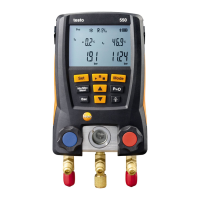
Do you have a question about the TESTO 550 and is the answer not in the manual?
| Accuracy Temperature | ±0.5 °C |
|---|---|
| Resolution Temperature | 0.1 °C |
| Battery Type | Alkaline or rechargeable battery |
| Connectivity | USB |
| Measurement Parameters | Pressure, temperature |
| Display | LCD |
| Power Supply | 4 x 1.5 V AA batteries or rechargeable battery |
| Interface | USB |
Guidance on reading the manual and understanding its symbols, safety instructions, and warning advice.
Precautions for safe operation, maintenance, and handling, including electrical and mechanical hazards.
Proper disposal of batteries and instruments, and adherence to environmental regulations for refrigerant gases.
Describes the testo 550's application in servicing refrigeration and heat pump systems by qualified personnel.
Lists detailed specifications: parameters, sensors, measurement ranges, interfaces, overload limits, and accuracy.
Visual identification of the testo 550's display, control elements, probe sockets, and battery compartment.
Explanation of each control key's function, such as Set, Mode, and Start/Stop buttons.
Step-by-step guide to opening the battery compartment, inserting batteries, and securing the cover.
Instructions for switching the testo 550 on, including the initialization phase and measurement view.
Guide to setting parameters like temperature/pressure units and selecting measuring modes before operation.
Details on how to use the valve positioner to open and close passages for refrigerant flow control.
Essential preparatory steps, including connecting sensors and ensuring the instrument is ready for use.
Instructions for connecting NTC sensors for pipe temperature and auto superheating/subcooling calculations.
Procedure for switching the instrument on and zeroing pressure sensors before starting measurements.
Guide to correctly connecting low-pressure (blue) and high-pressure (red) refrigerant hoses to the system.
How to select the correct refrigerant from the available list for accurate measurement readings.
Instructions on choosing between Refrigeration, Heat pump, and Automatic modes for measurement types.
Detailed steps for conducting measurements, including safety checks, pressurizing, and reading results.
Procedure for performing temperature-compensated tightness and pressure drop tests on refrigeration systems.
Guidelines for cleaning the instrument housing, keeping connections clean, and removing oil residues.
Recommendations for maintaining accuracy: regular leak checks and calibration.
Step-by-step instructions for removing old batteries and inserting new ones in the instrument.
Information that valve positioner or handle replacement is not permitted and requires customer service.
Answers to common questions and solutions for issues like automatic shutdown or display errors.
Definitions of key parameters like superheating (Δtoh), subcooling (Δtcu), and temperature readings.
Explanation of error messages and their causes, with guidance on contacting support for resolution.
List of available accessories and spare parts with article numbers, and where to find more information.